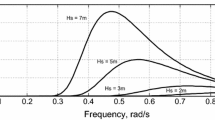Abstract
Since large heave and pitch motions of a high-speed multihull seriously affect the navigability of the ship, it is significant to design the effective anti-pitching control for the multihull. However, the existing anti-pitching controllers are all designed based on deterministic dynamics models and have disadvantages of low control robustness, high dependence on experience, high complexity and low anti-pitching performance, such that the applicability and effectiveness of the controllers can be severely deteriorated. In this paper, we propose a robust-decoupled anti-pitching controller composed of a proportional–differential (PD) control term and an extended state observer (ESO)-based uncertainty compensation term. Compared with the related results, the contributions of the proposed approach include: (1) the PD control gains are designed using the equivalent noise bandwidth theory based on the stochastic characteristics of the heave/pitch motions and (2) the control robustness is effectively improved by the ESO-based compensation. The stability of the closed-loop control system is proved by theoretical analysis. The effectiveness of the proposed algorithm has been verified by simulations and experiments in which the heave and pitch are reduced by 20–35% and 40–50%, respectively.





















Similar content being viewed by others
Abbreviations
- PID:
-
Proportional integral derivative
- PD:
-
Proportional derivative
- ESO:
-
Extended state observer
- QFT:
-
Quantitative feedback theory
- CFD:
-
Computational fluid dynamics
- ENB:
-
Equivalent noise bandwidth
- MSE:
-
Mean square error
References
Fossen TI (2011) Handbook of marine craft hydrodynamics and motion control. John Wiley & Sons Ltd, New Jersey
Yang SL, Zhang ZM (2000) High performance ship. National Defense Industry Press, Beijing
Esteban S, Giron-Sierra JM, Andres-Toro BD, Cruz JMD (2005) Fast ships models for seakeeping improvement studies using flaps and T-Foi. Math Comput Modell 41:1–24
Giron-Sierra JM, Recas J, Esteban S (2011) Iterative method based on CFD data for the assessment of seakeeping control effects, considering amplitude and rate saturation. Int J Robust Nonlinear Control 21:1562–1573
Yuan X, Zhang X (2017) The design of vertical damping appendage and the effect on trimaran. J Wuhan Univ Technol 41(4):554–558
Xi HD, Sun J (2006) Feedback stabilization of high-speed planning vessels by a controllable transom flap. IEEE J Oceanic Eng 31(2):421–431
Cruz JDL, Aranda J, Giron-Sierra JM, Velasco F (2004) Improving the comfort of a fast ferry. IEEE Control Syst Mag 24(2):47–60
Aranda J, Cruz JDL, Diaz JM (2005) Design of a multivariable robust controller to decrease the motion sickness incidence in fast ferries. Control EngPract 13(8):985–999
Santos M, Lopez R, Cruz JM (2005) Fuzzy control of the vertical acceleration of fast ferries. Control EngPract 13(8):305–313
Liu YW, Fang JZ, Qi ZG (2018) Control of vertical motion for high speed ferry. Electr Mach Control 22(1):114–120
Huang LM, Han Y, Duan WY (2018) Numerical and experimental studies on a predictive control approach for pitch stabilization in heading waves. Ocean Eng 169:388–400
Do KD (2016) Global robust adaptive path-tracking control of underactuated ships under stochastic disturbances. Ocean Eng 111:267–278
Javad A, Jason L, Michael RD, Damien SH, Giles AT (2019) An experimental investigation on slamming kinematics, impulse and energy transfer for high-speed catamarans equipped with Ride Control Systems. Ocean Eng 178:410–422
Gao Z (2006) Scaling and bandwidth-parameterization based controller tuning. In: Proceedings of the 2006 American Control Conference, 2006, Minneapolis, pp 4989–4996
Chen WH, Yang J, Guo L, Li S (2016) Disturbance -observer based control and related methods - an overview. IEEE Trans Ind Electron 63(2):1083–1095
Jong HW, Bernd E (2013) A tuning method based on signal-to-noise power ratio for adaptive PLL and its relationship with equivalent noise bandwidth. IEEE Commun 17(2):393–396
Mansilla RM, Aranda J, Manuel JD, Cruz J (2009) Parametric model identification of high-speed craft dynamics. Ocean Eng 36:1025–1038
Boris H (2019) System-based modelling of a foiling catamaran. Ocean Eng 171:108–119
Arribas FP, Clemente JA (2006) Strip theories applied to the vertical motions of high speed crafts. Ocean Eng 33:1214–1229
Amin N, Hashem N, Hassan G (2018) Performance prediction of hydrofoil-supported catamarans using experiment and ANNs. Appl Ocean Res 75:66–84
Farzam S, Wei Y, Brent Y (2019) Rapid estimation of PID minimum variance. ISA Trans 86:227–237
Kristian S, Anton C (2018) When is PID a good choice? IFAC-PapersOnLine 51(4):250–255
Liang LH, Wen Y (2018) Rudder roll stabilization with disturbance compensation model predictive control. J Mar Sci Technol 24(4):1–11
Acknowledgements
This work is financially supported by the National Natural Science Foundation of China (No. 51379044, 62073156), and the Priority Academic Program Development of Jiangsu Higher Education Institutions (No. PAPD-2018-87).
Author information
Authors and Affiliations
Corresponding author
Additional information
Publisher's Note
Springer Nature remains neutral with regard to jurisdictional claims in published maps and institutional affiliations.
About this article
Cite this article
Zhang, J., Liu, Z., Dai, X. et al. Robust decoupled anti-pitching control of a high-speed multihull. J Mar Sci Technol 26, 1112–1125 (2021). https://doi.org/10.1007/s00773-020-00791-w
Received:
Accepted:
Published:
Issue Date:
DOI: https://doi.org/10.1007/s00773-020-00791-w




